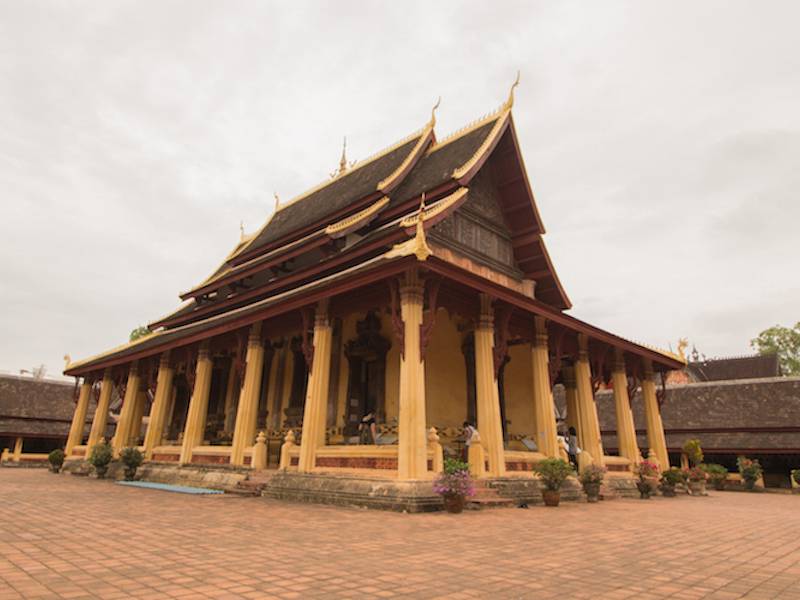*This weeks guest post on Wat Sisaket Vientiane comes from Alexandra Heidler of www.puzzledpilgrim.com, where she writes predominantly about Asia Travel.
“Recent” Addition Still Holds Ancient Flavour to Vientiane Temple Scene
Vientiane is practically littered with temples the way Europe is with castles. They’re everywhere! Many have a beautiful glimmering statues and edifices on their doors. They jump out against the other commercial buildings as you drive past in a Tuk-Tuk, or perhaps on a rented bicycle (a favourite way to get around the tiny city by tourists).
But, what if you want to get a touch of what Laos used to look like? Due to many invasions of the city, power disruptions, and neighbouring conflicts little is left that hasn’t been altered, repaired, or rebuilt. There is, however, one site in Vientiane that operates and has been left alone as it was built: Wat Sisaket Vientiane.
Wat Sisaket Vientiane
This Buddhist monastery and temple may be relatively new to the Vientiane (pronounced Vien-chien) scene, despite having been completed around 200 years ago in 1824. But, Wat Sisaket Vientiane is the oldest Buddhist place of worship in Vientiane to retain its original decorations and façade.
Why? Well, it was the only temple to have faced down the terrible 1828 Siamese invasion. An invasion destroyed other relics such as the national icon of That Luang, built back in the 3rd century.
The temple turned museum across the road Haw Phra Kaew, used to house the revered emerald buddha statue in 1565, has already undergone numerous transformations, the most recent being a very attractive flush of gold and red paint you can see beyond the wall it lies behind.
So, despite its place as a “recent” addition, it is considered a very important connection to the older visualizations and aesthetics of the Laos Buddhist faith.
Buddha Statues of Wat Sisaket Vientiane
Wat Sisaket is known for its iconic wall to wall display of thousands of Buddhist statues in all sorts of shapes and sizes. The materials range from clay, wood, stone, to metal and total over 6,000 statues. On the walls surrounding the compound are tiny carved crevices housing usually two small Buddhist figures with plenty of larger figures looming in front.
The Cloister for Chao Anouvong
In the middle of the compound, there is a cloister which served as a personal meditation space for Chao Anouvong, or Xaiya Setthathirath V. He was the last king of the Lan Xang Kingdom. Inside the cloister is a lively alter filled with a variety of more adorned Buddhist figures. Other parts of the chamber feature astounding artisan depictions of popular Buddhist stories at the time of Setthathirath V’S reign. They are also said to be selected as stories to inspire and remind Setthathirath of the qualities of a good leader.
If you wish to go inside, be sure to take off your shoes. The cloister is also a current place of worship so be careful not to step on the rug, but rather kneel and scoot across if you need to. Current efforts are being undertaken with the help of German conservationist Andrea Teufel, and a team of Lao artisans. The damage to these murals have developed largely due to capillary salt deposits that have formed as well as the level of moisture in the area.
Thanks to funding from the Embassy of Germany, the murals inside are on their way to getting a much-needed paint lift. At the time, the restoration efforts have been made visible as teams are working during visiting hours.
However, photography inside this space is prohibited either in an effort to maintain and respect the work these conservationists are doing or otherwise. I felt incredibly lucky to be witnessing some of these conservation efforts in effect, as one who has worked as a conservationist myself with rare and old photography prints.
Wooden Carved Nagas
Be sure to check out the beautiful wooden carved naga that guards the compound, measuring five meters long. Nagas (dragons or serpants) are a common icon in Laos decorations and are often depicted around entrances or stuppas that decorate many of the Buddhist temples and monasteries. The wooden decorations that adorn the windows, roof, and walls are also worth noting for their mix of Thai, Burmese, and Lao style.
There is also a wonderful drum tower at the entrance of Wat Sisaket. This tower is used to signal to monks and other Buddhists the time of prayer. It is also used during various ceremonies and celebrations in Laos like the Water Festival.

Buddhist Stupas of Laos
There are plenty of small stuppas that house the remains of devout and deceased Buddhists. A common practice and site in Laos. Many of the stuppas are beautifully decorated, often in white stone and painted gold. It is worth looking around as many of the stuppas will have a variety of offerings or engaging decorations found on them.
As always, modest dress is required when entering such places of worship. Be sure to wear something that covers shoulders, just above the knee, and if you wish to step inside the private meditation room wear some shoes that are easy to take on and off.
You can follow the author, Alexandra Heidler from Puzzled Pilgrim on Instagram and Twitter here…
Instagram: @PuzzledPilgrim
Twitter: @PuzzledPilgrim
Compare prices to stay neat Wat Sisaket Vientiane on booking.com.
You might also like to read about What to do in Siem Reap
